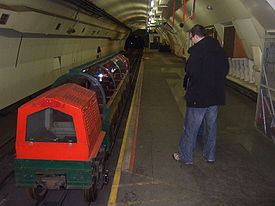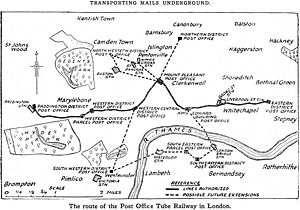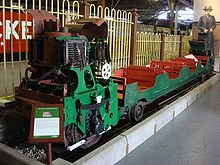- London Post Office Railway
-
The Post Office Railway, also known as Mail Rail, was a narrow-gauge driverless private underground railway in London built by the Post Office with assistance from the Underground Electric Railways Company of London to move mail between sorting offices. Inspired by the Chicago Tunnel Company,[1] it was in operation from 3 December 1927 [2] until 31 May 2003.[3]
Contents
Geography
It ran east–west from Paddington Head District Sorting Office in the west to the Eastern Head District Sorting Office at Whitechapel in the east, a distance of 6.5 miles (10.5 km). It had eight stations, the largest of which was located underneath Mount Pleasant, but by 2003 only three stations remained in use because the sorting offices above the other stations had been relocated.
History
In 1911 a plan evolved to build an underground railway 6½ miles long[4] from Whitechapel to Paddington serving the main sorting offices along the route; even then, traffic congestion was causing unacceptable delays. The contract to build the tunnels was won by John Mowlem and Company. Construction of the tunnels started in February 1915 from a series of shafts dug along the route. Most of the line was constructed using the Greathead shield system, with limited amounts of hand-mining for connecting tunnels at stations.
The main line has a single tube of 9 ft diameter with two tracks. Just before stations, tunnels diverge into two single-track 7 ft diameter tunnels. These then connect to two parallel station tunnels of 25 ft diameter. The main tube is underground at a depth of around 70 ft.[5] Stations are at a much shallower depth, with a 1-in-20 gradient into the stations. The gradients assist in slowing the trains when approaching stations, and accelerating them away. There is also less distance to lift mail from the stations to the surface. At Oxford Circus the tunnel runs close to the Bakerloo line tunnel of the London Underground.
During 1917, work was suspended due to the shortage of labour and materials. By June 1924 track laying had started. In February 1927 the first section, between Paddington and the West Central District Office, was made available for training. The line became available for the Christmas parcel post in 1927 and letters were carried from February 1928.
In 1954 plans developed for a new Western District Office at Rathbone Place which required a diversion to the line. The diversion came into operation in 1958.[6] It was not until 3 August 1965 that the new station and office was opened by the Postmaster General of the United Kingdom, Anthony Wedgwood-Benn. The disused section was used as a store tunnel; some parts of it still have the track in place.
Closure
A Royal Mail press release in April 2003 revealed that the system would be closed and "mothballed" (i.e. removed from active service) at the end of May that year. Royal Mail had earlier stated that using the Post Office Railway was five times more expensive than using road transport for the same task. The Communication Workers Union claimed the actual figure was closer to three times more expensive but argued that this was the result of a deliberate policy of running the system down and using it at only one-third of its capacity. Despite a report by the Greater London Authority in support of the continued use of Mail Rail, the system was taken out of use in the early hours of 31 May 2003.[3]
Some of the former Mail Rail trains have been preserved at the Launceston Steam Railway.[7] In April 2011 an urban exploration group called the "Consolidation Crew" published accounts of having gained illicit access to the Mail Rail tunnels. Detailed photography and textual description revealed that the system, despite some 'natural decay', is still in largely good condition.[8][9]
Rolling stock
The London Post Office Railway used various types of rolling stock during its history. The first stock was delivered in 1926 with the opening of the system. All stock used was electrically powered.
Electric locomotives
- 1926 Electric Locomotives — Original locomotives
Electric units
- 1927 Stock — Original stock
- 1930 & 1936 Stock — Replacement stock for 1927 Stock
- 1962 Stock — Prototype stock
- 1980 Stock — Replacement stock
In fiction
- The Post Office Railway features in the novel The Horn of Mortal Danger (1980). In the novel, there is a connecting tunnel between the Railway and the secret railway of the North London System. The only other known connection is in the disused tunnel between Highgate and the disused Cranley Gardens.
- The railway appears in the film Hudson Hawk, but rebadged as the 'Poste Vaticane' of Vatican City. Bruce Willis (as Hawk) stows away in one of the mail containers.
- A mail train system closely based on the Mail Rail is used in Charlie Higson's third Young Bond book, Double or Die.
Similar railways
An earlier underground railway system was used by the Post Office in London between 1863 and 1874. This was a pneumatic system using individual wheeled capsules, operated by the London Pneumatic Despatch Company.
In 1910 a tunnel railway merely 450m long, opened in Munich, Germany as a connection between the Munich Main Station and the nearby Post office. The tunnels were damaged in World War II, restored in 1948 and partially rebuilt in 1966 to allow for the first Munich S-Bahn tunnel. Operations ceased in 1988.
Other underground post railways existed in Lucerne, from 1927, and in Zurich, from 1937 until 1981, both in Switzerland.
The Chicago Tunnel Company delivered freight, parcels, and coal; and disposed of ash and excavation debris. It operated a 2-foot gauge track through an elaborate network of 7.5 feet (2.3m) × 6 feet (1.8m) tunnels running under the streets throughout Chicago's central business district including and surrounding the "Loop".
See also
- Subterranean London
- London Pneumatic Despatch Company
- List of British heritage and private railways
- Chicago Tunnel Company
References
- ^ Karslake, Colin. "Speeding London's Mail". MailRail.co.uk. http://www.mailrail.co.uk/. Retrieved 2009-08-19.
- ^ Subterranean city: beneath the streets of London. Antony Clayton. 2000
- ^ a b "Final delivery for Mail Rail". This Is Local London. 2003-05-30. http://www.thisislocallondon.co.uk/news/topstories/301893.final_delivery_for_mail_rail/. Retrieved 2009-08-19.
- ^ Romance of London's Underground, Ayer Publishing
- ^ Popular Mechanics Mar 1952. p.164
- ^ Institution of Civil Engineers (Great Britain) Proceedings: Volume 15 - 1960
- ^ Launceston Steam Railway
- ^ "Security-Breach: London Mail Rail". www.placehacking.co.uk. http://www.placehacking.co.uk/2011/04/24/security-breach-london-mail-rail/. Retrieved 2011-04-26.
- ^ "The Post Office Railway (Mail Rail)". www.silentuk.com. http://www.silentuk.com/. Retrieved 2011-04-20.
Further reading
- Bayliss, Derek A. (1978). The Post Office Railway London. Sheffield: Turntable Publications. ISBN 0-902844-43-1.
- "Post Office Underground Railway (Mail Rail)". British Postal Museum & Archive. http://www.postalheritage.org.uk/history/downloads/BPMA_Info_Sheet_MailRail_web.pdf.
- "The Post Office (London) Railway". The Post Office Electrical Engineers' Journal 21 (2): 147–154. July 1928.
- Mackay, A.C. (April 1966). "The New Post Office Railway Station at the New Western District Office". The Post Office Electrical Engineers' Journal 59 (1): 12.
- Finden, R.E; Piqué, P; Kettridge, K. (January 1984). "New Transformer/Rectifier Units for the Post Office Railway". British Telecommunications Engineering 2 (4): 256.
External links
- Enthusiast Website Unofficial MailRail Web Page
- Alternative link London Post Office Railway
- Detailed information on construction and operation.
- The British Postal Museum & Archive
- Silent UK Comprehensive detail, based upon complete exploration. (Web-Archived here)
- Place Hacking A collective report of the trespass into the network by urban explorers in 2011.
- Guardian article on proposed mothballing.
- GLA report on the closure in PDF format.
- Google map of the route and stations.
Categories:- London Post Office Railway
- Electric locomotives of Great Britain
- Industrial railways in England
- Underground railways
- 2ft gauge railways
- Subterranean London
- History of rail transport in London
- Postal history of the United Kingdom
Wikimedia Foundation. 2010.



